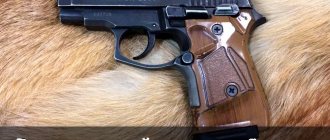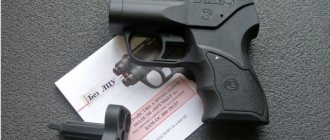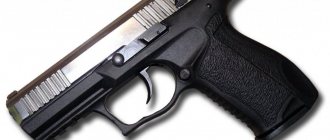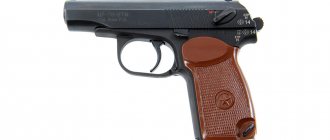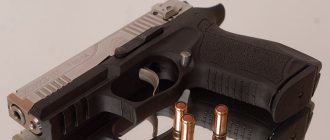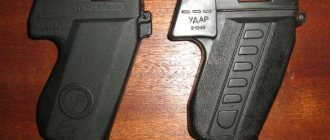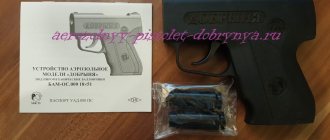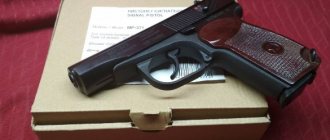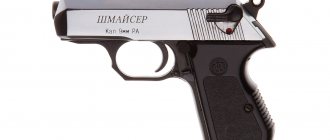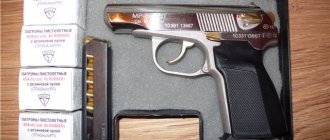Gas pistol
According to the principle of operation, the model is similar to a firearm . The charging mechanism is identical; unitary cartridges . A gas pistol fires a gas-forming projectile, which includes:
- Active powdery substance.
- Explosive powder charge.
Upon combustion, the powder charge (or its equivalent) becomes a gaseous state with high temperature and pressure. An aerosol jet is ejected from the barrel channel under the force of gas.
The active substance is in the state of a crystalline powder . When exposed to temperature and pressure, it becomes an aerosol cloud, ejected at a distance determined by the caliber, type of ammunition and dissector device.
The weapon's range is short, as the cloud quickly dissolves in the atmosphere. Already at 5 meters there is practically no stopping effect.
Some models include attachments for flares . They can be used in an emergency in an unfamiliar natural area, or to scare away animals.
When contacted with a mucous membrane or area of skin, the substances cause an irritating or tear-producing effect.
In terms of force, a point-blank shot is comparable to a punch . Afterwards, a hematoma the size of a palm and a burn remain on the body. When using gas weapons indoors, partial intoxication of the body is possible. It is necessary to immediately leave the room so that the gas does not poison the respiratory system, and then the entire body.
History[edit | edit code]
In 1939, a demonstration model of a police revolver shotgun with an 18-round drum and a firing range of up to 100 meters was presented in the United States, the ammunition for which was 25-mm shells (the shell case contained a tear gas charge in a paper closure)[2]. In 1941, a simplified single-shot version of a shotgun with a new type of ammunition was introduced (an insecticide charge in a paper cap, collected in a rifle cartridge case), which was advertised as a means of controlling insect pests in fruit orchards - one shot ensured pollination of one fruit tree with pesticides [3].
Traumatic pistol
The model is an exact copy of a firearm. Many traumatic pistols have a clip of only 2 rounds , which is not practical. The minimum quantity is 4 rounds . Traumatika shoots rubber bullets.
All models have a shelf life. The average number of shots for a traumatic pistol is 500 . The parameter depends on the design and features of the firing mechanism. Internal contacts can oxidize due to exposure to moisture and dirt. After a few years, the weapon will fail, even if the number of shots fired was minimal for a long time.
Aluminum and steel alloys are considered the most durable . The barrel can withstand heavy loads, so these models are suitable for training shooting.
Barrelless pistols have reduced dimensions , which is convenient for concealed carry. The weapon is traumatic, but the design has been changed. The standard number of charges is 1-4 , but there are models designed for larger shots. For the barrelless device, traumatic, blank, signal and light-noise cartridges are available.
General characteristics
Gas and traumatic pistols are used for self-defense . The weapon is not capable of causing grievous bodily harm. The shot is enough to temporarily disarm the enemy and escape.
Self-defense pistols have small dimensions . This allows you to take the model with you without allocating a lot of space in your bag or pocket.
Externally, the self-defense tool looks like a firearm. The differences are noticeable only upon detailed inspection.
Some models of traumatic pistols have the function of firing gas cartridges. Reloading is carried out manually (jerking the shutter after each shot).
Aerosol devices: replace the “rubber” with pepper.
My personal choice (like the choice of many other people) fell on aerosol devices or, in a simplified version, aerosols.
The principle of operation of this weapon is quite simple: BAMs (Small-sized Aerosol Cans) are charged into the cassette or magazine of the device, and, if necessary, a person, pressing the trigger, sends a mixture of irritants to a dangerous target.
The active substance of this weapon is not dangerous to the life of the attacker: its goal is not to hit mechanically, but to stop and disorient for a while so that the defender can retreat safely.
There are many similar pistols on the Russian market: Pioneer, Premier, Dobrynya, UDAR (UDAR-M2):
Premier-2 and Dobrynya, Tula “A+A”
Premier-2 and Dobrynya, Tula “A+A”
Distinctive features
- Impact on the enemy . A gas gun causes various types of irritation: tearing; skin and eye disorders; burns. Trauma causes physical harm. Hematomas and abrasions remain on the skin.
- Impact on others . A traumatic weapon shoots only one person. Those around you do not take damage unless they were the target of the shooter. A gas gun, when used in a confined space, can cause harm to all people in the room, since the aerosol substance completely fills the atmosphere of the room.
- Bullets . Aerosol weapons have a wider selection of cartridges, since there are quite a lot of chemical compounds that cause disturbances in the functioning of the body. Rubber bullets are used for trauma.
- Hit . The gas gun disperses crystalline powder, which is converted under pressure and temperature into an aerosol state. Since rubber cartridges are used in trauma weapons, the enemy receives an accurate blow to a specific part of the body.
- Workout . When using traumatic weapons, accuracy is important. It is recommended to undergo training in the use of the device, or regularly train in equipped shooting ranges or training grounds. There is no requirement to take an operational course to use an aerosol weapon. When used, the fact of the shot itself is important, not its accuracy.
- Availability of a license . No permit is required for the storage and use of traumatic weapons, unlike a gas pistol, which is a prohibited weapon.
- Operating principle . In a traumatic gun, a shot can be fired by burning gunpowder or expelling gas. An aerosol gun is a firearm.
- The effectiveness of self-defense . If a person is attacked by a group of bandits or robbers, a gas pistol is most effective, since it will almost instantly neutralize the entire group at once. When using trauma against several people, a quick reaction is required. If the device must be reloaded after each shot, it is ineffective in this situation.
What is the difference between a pneumatic and a traumatum - differences, similarities
Purchasing a pistol is a responsible undertaking in which you need to know many features. And it doesn’t matter what the weapon is chosen for: entertainment, sport or self-defense. Most people don’t know the difference between a pneumatic and a trauma, and sometimes their own lives depend on it.
Pneumatics
| Advantages | Flaws |
| Almost all pistols are copies of military weapons | Many models do not have sight adjustment |
| Self-tuning | Requires the use of gas cylinders, which means additional costs for their purchase |
| Entourage | All control units are designed for right-handers; left-handers may find pistols inconvenient |
| Reliability of all mechanisms | Many pistols are plastic |
| A can of CO2 is enough for 70 shots | Some models have a complex design of the trigger, which sometimes causes difficulties in disassembly |
| Simplicity of design | Narrow scope of use, not used for self-defense |
| Maintainability | Requires compliance with safety measures due to the explosion hazard of carbon dioxide cylinders |
| Affordable price for entry-level weapons | It is not always possible to find additional accessories for tuning |
Trauma
| Advantages | Flaws |
| Available type of cartridges, their variety and modification (signal, lighting, light and sound, gas) | Sometimes a small number of rounds are placed in the magazine (some models are designed for 4-5 rounds) |
| Effective range – up to 15 meters | Short-barreled models have low kinetic energy of bullet flight |
| Simplicity of design and ease of maintenance | The need to buy a holster |
| Availability of double action trigger | High price of both pistols and ammunition for them |
What is the difference between pneumatic and traumatic?
When using pneumatic weapons for plinking, sport shooting or hunting purposes, the operating time of this pistol is maximum.
Pneumatics are more used for recreational and sport shooting.
As for the use of this equipment for self-defense, the desired effect can only be achieved with skillful handling of weapons.
When fired from an air pistol, the bullet can cause little damage, but sometimes this is enough to force the attacking person to move away.
The purchase of trauma equipment requires appropriate permission. Buying such a pistol is a responsible process. It is necessary to learn many features that are of no small importance.
When choosing a weapon, the main tasks are important: what exactly is the gun being bought for: self-defense or for entertainment. Potential buyers often do not always know the difference between an injury and a pneumatic gun.
Air pistols are now common. Since licenses are not required to purchase them. As a rule, they are used for sporting and hunting purposes. Many owners are convinced that this equipment can be used for self-defense.
However, these actions are subject to criminal or administrative penalties. The difference between trauma and a pneumatic gun is that a pneumatic gun uses carbon dioxide under pressure and bullets from different metal alloys.
Air guns that are used for hunting purposes on small birds and animals are called “breakdowns.” The initial speed of a bullet when fired can be up to 405 m/sec. And the lethal flight speed is up to 250 m/sec. Like any weapon, it is advisable to keep pneumatics in a holster. It also requires care and maintenance.
In their design, traumatic pistols are more reminiscent of military analogues of weapons; a permit is required for them. These varieties are divided into fire and gas pistols.
The difference between traumatic weapons and real analogues is the characteristics of the bullet. For injury, rubber balls with a steel core are used.
In case of a gunshot wound, doctors have the opportunity to see the bullet on an x-ray.
There are types of traumatism that use sound and flash-noise cartridges. The main difference between a travmat and a pneumatic gun is its purpose. Trauma is used for self-defense purposes. By law, this pistol must be stored in a specially installed gun cabinet secured to the wall.
What is more dangerous, injury or pneumatic
The difference between a trauma weapon and its combat counterpart is that this weapon was not created to destroy enemy personnel. The characteristics have been designed to create a stopping effect.
This was achieved thanks to an increased caliber, reduced bullet speed when fired, and the use of special materials during production.
Also, a traumatic pistol is usually made smooth-bore with low accuracy: a person in self-defense does not need to shoot at an attacker from a distance of 30 m - the meaning of the definition of self-defense is lost.
But a shot from a wound can be fatal. During its development, engineers proceed from the fact that a rubber bullet must stop a person when shot in the torso.
This is the most protected and large enough target to hit in self-defense. But often the shot, which is made in a critical situation, is made in the head area.
When a bullet from a traumatic pistol hits the neck, eye, or temple, the attacker’s death is not only probable, but also possible.
When handling an injury, it is worth remembering that this gun is not a toy and prepare for the fact that the weapon can cause serious harm to a person or kill him - both the owner if handled improperly and the attacker. Its use must be precisely justified by the current situation.
Pneumatics are regulated separately in legislation. These pistols are not considered weapons for self-defense; they should only be used at training grounds or in special shooting ranges, and carrying them loaded is prohibited.
This is a very important amendment. Today, air pistols are quite popular. Their storage and carrying is almost not regulated by law. Teenagers can own these weapons; this, naturally, leads to various excesses - from shots through the window in the windows to proceedings in courtyard fights.
It is wrong to consider “air guns” as a pistol for self-defense. However, many sellers in gun stores display goods this way. In a real “combat” situation, pneumatic guns will not help stop the attacker. On the contrary, as statistics have shown, the use of this pistol infuriates the attacker and instead of the expected result, the opposite effect occurs.
Which is better, trauma or pneumatic
Traumat and pneumatic are two completely different types of pistols. The only thing they have in common is that they are not considered military weapons. Therefore, the choice of shooting devices can be made taking into account the purpose of the weapon and the main differences:
- The trauma gun shoots rubber bullets with a steel core inside, while the pneumatic gun shoots metal bullets.
- To purchase a traumatizer, you must obtain a special license. Air guns do not require a permit.
- Pneumatics are a training pistol that is often used for hunting purposes and for recreational entertainment. Traumatic weapons are closer to the real thing.
- The price of a traumatizer is usually much more expensive. Although certain air pistols reach a cost of several thousand dollars. But you can also buy cheap models - for 5-8 thousand rubles.
- Trauma can cause significant harm when it hits a person, sometimes to the point of death. Pneumatics cause almost no harm to the body. Often, traumatic pistols are carried by police officers to subdue violent people.
That is, there are not many common features: the similar name of the pistol (in the abbreviation), and the fact that they sometimes have an appearance that is similar to a real weapon.
An air pistol uses a small bullet as a cartridge; it is pushed out by a piston under the influence of carbon dioxide, which is under pressure in the can. For a traumatist, this is a powder charge. The dimensions of the rubber bullet (usually with a steel core) are also appropriate.
In terms of legislation, the difference between pneumatic and traumatic weapons is also significant. The first option relates more to a toy, and the second is a weapon; to purchase it, you need to submit a list of necessary documents to the Ministry of Internal Affairs, as well as organize proper storage.
Also, if you consider whether to choose pneumatic or traumatic, you need to highlight the likely impact. A pneumatic gun can only pierce a person’s skin or get stuck, for example, in a leather jacket.
Serious injury can only occur if it hits the face. Trauma, even when hit in the torso, can leave large bruises.
If hit in the face, a rubber bullet can be fatal.
What is more powerful, trauma or pneumatic?
Pneumatics are very common today due to the fact that no license is required to purchase them. This weapon is relevant for hunting and recreation, but not for self-defense. But for some reason, some believe that this pistol can be used for self-defense.
As a rule, bullets made of steel, lead and other similar materials are used for shooting. As for hunting pneumatic weapons, in this case it is best to choose the “break”, the initial speed of the bullet reaches 405 m/sec. The bullet speed of a pistol, which fires using a gas cylinder system, is in the range of 120-220 m/sec.
Traumas are much closer to their combat counterparts; you need permission to purchase them. In fact, they belong to firearms, there is only one difference - the properties of the bullet. The traumatic gun uses rubber balls rather than steel ones. The main purpose of a weapon is self-defense.
So, what is the difference between a traumat and a pneumatic? To purchase a traumatic pistol, a permit is required; for a pneumatic pistol, it is not required.
Another important difference is the material used to make the bullet: for a bullet it’s rubber, for a pneumatic gun it’s steel. The use of a traumatic pistol can cause death.
These weapons are more expensive than pneumatic weapons. Pneumatic equipment is used for hunting and gaining shooting skills.
Source: https://pnevmatiky.ru/all/chem-otlichaetsya-pnevmaticheskij-pistolet-ot-travmaticheskogo
Which self-defense tool is better?
It is impossible to predict under what circumstances self-defense will be needed:
- Indoors or outdoors.
- Against one bandit or a group of people.
- With or without witnesses.
Traumatic weapons are more accessible because they do not require a permit . A gas pistol requires a license to use.
It is better for an inexperienced user to purchase an aerosol weapon, since specialized skills are not required to use it. If a person wants to have a more professional remedy, they can use traumatism.
MiscellaneousComment
Legal status and history of application by country[edit | edit code]
Hungary[edit | edit code]
Gas pistols and revolvers are allowed to be purchased as civilian self-defense weapons[8].
Germany[edit | edit code]
Gas pistols and revolvers that have been certified by the Physikalisch-Technische Bundesanstalt center are allowed to be purchased as civilian self-defense weapons by German citizens over 18 years of age.
Kazakhstan[edit | edit code]
Gas pistols and revolvers are permitted as civilian self-defense weapons[9].
Russian Federation[edit | edit code]
The first gas pistols and revolvers (foreign-made) appeared in the USSR at the turn of the 1980s - 1990s; their widespread distribution in the CIS countries was greatly facilitated by the difficult criminal situation[10][11].
On November 8, 1992, the acquisition, carrying and use of foreign-made gas weapons was permitted[12]. In 1993, production of the first domestic gas pistol IZH-76[13] began; later more advanced models were developed. As of the beginning of 1998, Russian citizens had almost 1.1 million gas pistols and revolvers in their hands[14].
In 1998, on the territory of the Russian Federation, during operational search and preventive measures, internal affairs bodies seized 22 thousand gas pistols and revolvers, and during 1999 - about 25 thousand [15], but its number increased in the future, until the appearance of traumatic weapons in 2004.
After this, a partial “re-equipment” of citizens occurs - when purchasing traumatic weapons, gas weapons are often handed over for consignment or recycling (since they have a rather limited resource).
However, the total number of self-defense weapons among the population was increasing - as of the beginning of 2009, Russian citizens owned over 1.5 million units of gas revolvers and pistols (including “gas weapons with the ability to fire rubber bullets”)[16].
A certain number of gas weapons were lost and stolen[17]: as of January 1, 2006, 41 thousand gas pistols and 8.5 thousand gas revolvers were on the federal wanted list.
Any citizen of Russia who has reached 18 years of age (Federal Law No. 150, Article 13) can purchase a gas pistol or revolver after obtaining a license to purchase it from the internal affairs bodies at the place of residence.
In accordance with Article 24 of the Federal Law “On Weapons”, citizens of the Russian Federation can use the weapons they legally have to protect life, health and property in a state of necessary defense or emergency[18]. The concepts of states of necessary defense and extreme necessity are set out in Articles 37 and 39 of the Criminal Code of the Russian Federation.
Ukraine[edit | edit code]
Certified gas revolvers and pistols have been allowed to be purchased as civilian self-defense weapons since 1993[19], after obtaining permission to purchase and carry them from the internal affairs bodies at the place of residence.
South Africa[edit | edit code]
As civilian self-defense weapons, it is permitted to use pneumatic paintball pistols equipped with gelatin bullets with an irritant or lachrymator.
- As an example, HM Security produces the single-shot Goblin Solo Paintball Pistol, the Tippmann TPX Pistol semi-automatic pistol and several variants of sporting paintball rifles that can fire gelatin bullets[20]
In the USA, similar firing devices are produced by Kimber Manufacturing - under the names PepperBlaster and PepperBlaster II.
